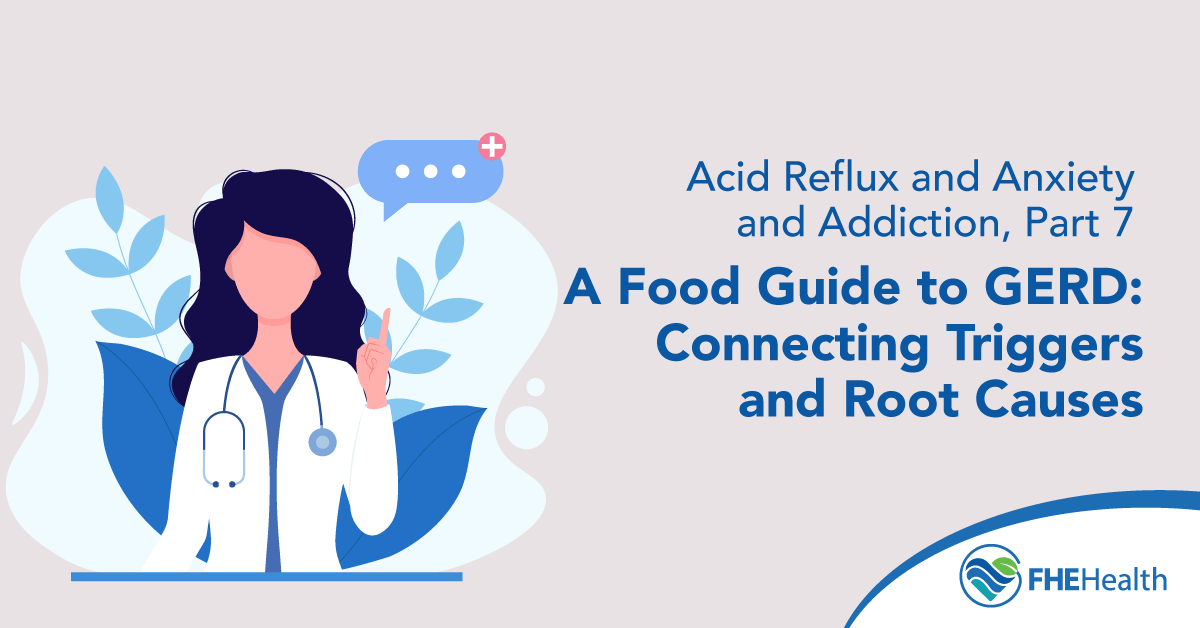
Food is an obvious part of the puzzle when addressing reflux, but it isn’t so obvious which foods need to be added to the diet or why certain foods act as triggers. Throughout this series, we have discussed the root causes of GERD and mentioned specific foods that could be triggers, depending on the root cause.
In this final post, we will bring all the potential food contributors together for you. Sometimes, by noticing patterns in what foods are bothering you and what diets are helping you, you can figure out the underlying cause of your reflux. The goal of this final post is to serve as a quick reference guide in this process.
Foods that can be involved in reflux are categorized into six groups:
- foods that irritate a compromised stomach and esophagus
- foods that relax the gate between the stomach and esophagus (lower esophageal sphincter, also known as LES)
- foods that trigger bile reflux
- foods high in histamine
- a poor diet lacking in foods that support a healthy gut
- and food sensitivities that can manifest as reflux.
Keep in mind that not all of these foods are problematic for everyone with GERD. The goal is to identify patterns in your symptoms, so you can determine if any of them may be relevant to you.
Common Food Triggers for Reflux
Below is a list of food triggers for reflux, ranging from the more common to the less common. These may or may not affect you, depending on your individual triggers and underlying causes:
Common Food Triggers
- Tomato
- Citrus
- Alcohol
- Carbonated beverages
- Coffee
- Chocolate
- Fried and oily foods
- Spicy foods
Less Common Triggers to Watch for
- Onion
- Garlic
- Lactose
- Vinegar
- Sugar
- Other fruits
- Peppermint
Foods That Can Irritate a Compromised Stomach and Esophagus
Acidic foods such as citrus-based and tomato-based products can exacerbate reflux symptoms for many (but not all) people with GERD. The acidity of these foods is more likely to affect those whosee mucosal layer, which protects the stomach and esophagus, has deteriorated. Once you address the underlying cause, as discussed in previous posts, adding foods and herbs that heal and protect the mucosal layer is a great addition to accelerate the recovery process. Foods and supplements such as aloe, manuka honey, DGL, slippery elm, zinc carnosine, and marshmallow are excellent options. See Part 4 of this series for supplement suggestions.
Many underlying causes can contribute to a compromised lining of the stomach and esophagus, so symptoms with these foods don’t necessarily help you narrow down the underlying cause of the problem. However, I would say that if you do not experience symptoms with acidic foods, this could be a sign that your stomach lining is intact and that you might have an issue with insufficient stomach acid, motility, or bile reflux.
Foods That Can Relax the LES
Many foods contribute to reflux symptoms because they are known to relax the lower esophageal sphincter (LES), a part of the GI tract we have discussed extensively in this series. As it turns out, the level of efficiency displayed by this guard gate between the esophagus and the stomach is often a key culprit in the underlying cause of GERD.
Foods that have been shown to relax the LES include coffee, chocolate, high-fat foods, peppermint, alcohol, carbonated beverages, and any other foods that cause excess pressure in this region. This includes anything that can slow down motility as well as foods that lead to excess fermentation, which cause the buildup of gas, bloating, and pressure. We will discuss this more when exploring the role of a poor diet contributing to reflux.
Foods That Trigger Bile Reflux
Bile is secreted from the gallbladder and helps emulsify fats, neutralize acid, and kill bacteria. For many people, when the gallbladder is removed, bile is not secreted in the right amount and at the right time.
While more common in those without a gallbladder, bile issues can occur in other people as well. If high-fat diets are triggering your acid reflux, especially if you have had your gallbladder removed, you are more likely to need to use supplements to be able to tolerate higher amounts of fat in the diet.
It is important to note that a high-fat meal can also relax the LES, leading to reflux as well. Therefore, we can’t say for sure that symptoms with high-fat foods are a bile issue. If high-fat foods are the only foods that cause symptoms and you have green or chalky grey-white stools or pain under your right lower rib, there’s a higher probability that bile is the issue. In this case, see Part 3 of this series.
Histamine Intolerance
This was discussed in Part 6 of this series. Many common foods (such as tomatoes, citrus fruits, coffee, chocolate, and alcohol) and less common foods (like vinegar and other fruits) that trigger reflux in people happen to be “high histamine” foods.
Usually, if histamine is a cause of reflux, you would also have chronic common symptoms of histamine intolerance. If you have frequent issues in the areas below, it might be worth testing out a low histamine diet. If you notice improvements in GERD and/or other symptoms, I’d recommend consulting a knowledgeable healthcare provider, since treating this condition can be nuanced. For suggestions on supplements that I’ve used to successfully manage reflux from histamine intolerance, see Part 6.
These are some of the common symptoms that might be connected to histamine intolerance:
- Head: Headaches or migraines, dizziness, lightheadedness
- Skin: Flushing, skin rashes (like hives), itchy skin or eyes
- Respiratory: Nasal congestion, runny nose, asthma-like symptoms (wheezing, shortness of breath)
Poor Diet
There are two main areas where a poor diet can lead to reflux: the presence of foods that impact motility and foods that affect our microbiome. You will notice there is quite a bit of overlap with these foods.
Fiber or Lack Thereof
It is also possible that reflux can develop secondary to a poor diet. There are multiple reasons why a poor diet can cause or contribute to reflux:
- Fiber is needed for healthy gut motility. The Standard American Diet (SAD) is typically low in fiber, which can lead to constipation. This backs up the system, leading to more gas and bloating, which puts even more pressure on the system, ultimately causing the relaxation of the LES.
- A SAD diet is also high in sugar, which has also been shown to contribute to reflux. In fact, numerous studies have shown that a low-sugar diet or a low-carb diet can help resolve acid reflux in many people. One study noted that the biggest difference in symptoms was more related to refined carbohydrates, such as white flour and sugar, rather than complex carbohydrates (which are high in fiber). For this reason, I don’t typically recommend a low-carb diet, but rather a diet that limits sweets and white flour.
Microbiome,Dysbiosis and SIBO
Our microbiome plays a central role in the functioning of our digestive system. It is well established that this significantly influences gut motility, and conversely, gut motility affects the microbiome. Therefore, motility issues and a compromised microbiome often co-occur.
Foods that support a healthy microbiome:
- High fiber diet
- Diet rich in phytochemicals (the compounds that give fruits and vegetables their color) such as polyphenols
- Fermented foods such as yogurts, raw fermented vegetables, tempeh, and miso
Diets that negatively impact the gut microbiome:
- High saturated fat diet
- Diet high in white flour/white sugar
- Low-fiber diet
Small Intestinal Bacterial Overgrowth (SIBO) and Dysbiosis
SIBO was discussed earlier in this series when we were discussing motility, but it can also occur after having your gallbladder removed or secondary to improper bile flow (6). For those with SIBO, foods high in Fermentable Oligosaccharides, Monosaccharides, and Polyols (FODMAPs) often exacerbate symptoms, but are not the underlying cause of the problem. Still, a low-FODMAP diet may help provide symptom relief and reduce gas and bloating, which can put pressure on the stomach and lead to reflux. In this case, it is crucial to address the underlying cause of SIBO, rather than simply following a low-FODMAP diet. Once you treat SIBO and address the underlying cause, most people do not feel symptoms from high FODMAP foods anymore.
It is a little more challenging to track your symptoms with FODMAPs because the issue with these foods is not all or nothing; it is an issue of volume of intake, unlike a food allergy, where you have to be strict.
If you experience issues with the below foods, whether with or without reflux, you may have SIBO. Consider trying a low-FODMAP diet and consulting with a knowledgeable healthcare provider for treatment if this is the case. Here is a list of some foods that are high in FODMAPs. Consider downloading the Monash University app for the most comprehensive list of foods high in FODMAPs, or purchase a book with recipes if you suspect you have issues with these foods.
High FODMAP Foods
Fruits
- Apples
- Pears
- Mango
- Cherries
- Peaches
- Plums
- Nectarines
- Apricots
- Vegetables
- Garlic
- Onion
- Cauliflower
- Broccoli
- Brussels sprouts
- Asparagus
- Artichokes
- Mushrooms
- Sugar snap peas
Other
- Foods containing lactose
- Most wheat products
- Most beans
- Sugar alcohols
Food Sensitivities
All the other foods discussed above do not need to be removed permanently from the diet as long as the underlying cause of the reflux is resolved. However, with food sensitivities, the food is the underlying cause of the problem. If someone is allergic or sensitive to a specific food, it can manifest in various ways.
People often think of lower abdominal pain or diarrhea when it comes to food sensitivities, but reflux is a possible symptom as well. Food sensitivities are frequently overlooked as a possible cause of acid reflux. The truth is that there is very little research even discussing the idea that food sensitivities can cause acid reflux. However, a couple of studies have shown that removing potential food sensitivities can resolve GERD (4-5).
If common food triggers don’t trigger your reflux symptoms, then it might be worth testing the elimination of common food sensitivities. Two of the more common food sensitivities are to gluten and dairy, and some people think they might have a sensitivity to gluten and/or dairy, when really it could be a lactose intolerance and/or a FODMAP issue.
If the only issues are with gluten and/or dairy, and you have no other problems with high FODMAP foods, it is more likely to be an intolerance to just gluten and/or dairy. Conducting an elimination diet, where you eliminate gluten and dairy for a couple of weeks, can help you determine if these foods are a problem for you. If you still have issues, it might be a FODMAP issue or have nothing to do with any of these foods. Check out the sample menu at the bottom of my article on common food sensitivities to support anxiety and depression here.
Closing
As you can see through this seven-part series on GERD, if you really want to get to the root of the issue and hopefully wean off GERD medication, you have to be an investigator. Look for patterns based on what you have read. Work with a knowledgeable healthcare provider! You do not have to do this alone.
As you can see, GERD is a complex condition, and it isn’t always easy to diagnose on your own. Even with a knowledgeable healthcare provider, there may be trial and error involved in figuring it out. Hopefully, this series helps you understand that it is possible to address reflux and wean off of medication (under the supervision of your doctor) that has potential risks when taken long-term.






